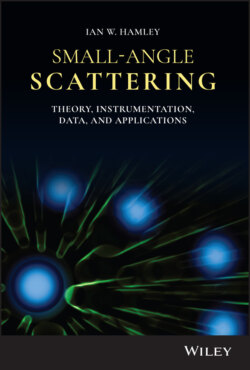Читать книгу Small-Angle Scattering - Ian W. Hamley - Страница 25
1.7 FORM FACTORS 1.7.1 Examples of Form Factor Expressions
ОглавлениеAnalytical expressions are available for the form factor of particles of many geometries, as well as polymers discussed in Section 1.8. Some examples of more commonly used form factors are listed in Table 1.2. Extensive compilations of form factors are available [7, 17, 18, 21, 55].
Table 1.2 Expressions for common form factors.
| Form factor | Equation | Parameters |
|---|---|---|
| Homogeneous sphere | Radius, R (), Scattering contrast, Δρ | |
| Spherical shell | P(q) = [Ks(q, R1, Δρ) − Ks(q, R2, Δρ(1 − μ))]2 Ks(q, R, Δρ) as for a homogeneous sphere as above (other parameterizations are possible) | Outer radius R1 with shell scattering contrast Δρ Inner radius R2 with core scattering contrast Δρ(1−μ) |
| Gaussian polymer chain –Debye function (see Section 1.8 for derivation) | I0, forward scattering intensity Rg, radius of gyration (b, statistical segment length) | |
| Sphere with attached Gaussian chains (used for block copolymer micelles) [52, 53] | where and with | Nc, aggregation number R, core radius Rg, radius of gyration of attached chains d, displacement of chains (for non‐penetration into core, d ≈ 1) Δρs, scattering contrast of spherical core Δρc, scattering contrast of attached chains |
| Ellipsoid of revolution (spheroid) | Ks(q, R, Δρ) as for a homogeneous sphere as above (other parameterizations are possible) | Radius in polar direction Rp Equatorial radius Re = νRp Scattering contrast, Δρ |
| Tri‐axial ellipsoid | P(q) = ∫ [Ks(q, R(a, b, c, α, β, Δρ)]2 sin αdαdβ R(a, b, c, α, β) =[(a2sin2β + b2cos2β)sin2α + c2cos2α]1/2 Ks(q, R, Δρ) as for a homogeneous sphere as above (other parameterizations are possible) | Semi axis lengths a, b, c Scattering contrast, Δρ |
| Rectangular parallelepipedons (including cubes) | Where | Edge lengths a, b, c Scattering contrast, Δρ |
| Circular cylinder | Radius, R. length, L. Scattering contrast, Δρ | |
| Infinitely thin circular disc | Radius, R Scattering contrast, Δρ | |
| Lipid bilayer with Gaussian scattering density profile (within a disc) | P(q) = [Pdisc(q)/(Δρ)2]Pcs(q) where the cross‐section form factor Pcs(q) is | Cross‐section parameters illustrated in Figure 1.16 |
| Helices and helical tapes (Pringle–Schmidt form factor [54]) | Here and ɛ0 = 1 and ɛn = 2 for n ≥ 1 | H helix length, P helix pitch, other parameters defined in Figure 1.16 |
Figure 1.16 Parameters for complex form factors. (a) Gaussian bilayer, (b) Projection of a helical structure showing definitions of angles and radii in the corresponding Pringle–Schemidt form factor (Table 1.2).
The form factors for particulate systems of different dimensionality can all be expressed in terms of hypergeometric functions [27].
